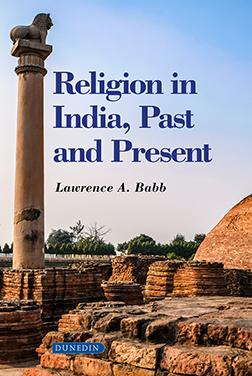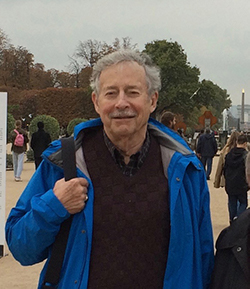

Religion in India, Past and Present
By Lawrence A. Babb, the Willem Schupf Professor of Asian Languages and Civilizations and professor of anthropology, emeritus
Dunedin Academic Press
How many textbooks morph into a story you can’t put down? Lawrence Alan Babb’s Religion in India, Past and Present might be the first. You start with a carefully modulated account of the Indian subcontinent as it was 4,000 years ago—or at least as we think it was—and you end in the middle of the controversies that are tearing at the fabric of India today. These battles almost always have a religion dimension, sometimes front and center. Babb’s wonderfully balanced perspective on the historiography—the “good horse sense” that my father would have praised—yields progressively to the excitement of someone caught up in the very thing he describes.
Many textbook-level studies of Hinduism brush aside a major puzzle at the beginning: Hinduism, the English word, corresponds to nothing in Sanskrit or the ancient Vedic corpus that Hindus often claim as the bedrock of their faith and practice. The textbook writers tip their hats to the issue, then set it aside. Not Babb. He pulls this controversy forward—was Hinduism “invented” in the early 19th century as a product of India’s encounter with the British?—and puts it where it belongs, in his chapter on “Religion and the Raj.” There it takes its place alongside caste, religious reform (sound Protestant?) and that distinctively Hindu presence in modern-day Indian politics, the cow protection movement.
More boldly still, he situates much of the drama of Hindu self-definition in the context of the presence of Islam in South Asia. That rightly becomes the theater where some of the most important players in Hindu life walk onstage: the vernacular bhakti (devotional) poet-saints whose utterances fill textbooks, temples, films, videos and websites worldwide. Babb points out that the political and religious presence of Islam in early modern India hardly diminished the power or creativity of Hindu life. To the contrary, “the entire period … saw an extraordinary efflorescence of devotional Hindu traditions,” and not just Hindu but Sikh, Sant and Jain.
This book lays the groundwork for readers to understand politics in India today.
The tempo quickens with the advent of British colonial rule—railroads, the printing press, telegraphy, chromolithography and “the velocity of symbols” they propelled. But real people matter too. We see how Gandhi’s shyness, initially crippling, vanished when he faced racial prejudice from whites in South Africa. Babb notes that it was a Muslim businessman who invited Gandhi to make the journey there, yet he also highlights the fact that Gandhi’s relationship to Muslims was complex. Gandhi valued the teachings of all religions—emphatically including Islam—but his particular brand of Hindu-Jain householder piety caused him to support “cow protection” and praise the cow as a “poem of pity.”
This brought him into apparent alignment with some other Hindus who ratified their masculinity—sometimes violently—by defending the cow as a divine mother, in “a riposte to [British] stereotypes of Hindu fecklessness and passivity,” as Babb writes. It also seemed to configure Muslims as being less than fully Gandhian, since a number of them tan hides or eat beef. More generally, the fact that Gandhi’s political persona was suffused with such Hindu religious symbolism as cow veneration alienated some Muslim leaders of the period. Ominously, this included Muhammad Ali Jinnah, who later became the principal strategist in the creation of Pakistan. The partition of the subcontinent was the great disappointment of Gandhi’s life.

At Amherst, Babb taught courses in Indian civilization, anthropology of religion and more.
Reporting this drama with an exquisite sense of proportion, Babb lays the groundwork for readers to understand how the odious Citizenship Amendment Act of December 2019 could have emerged from Narendra Modi’s BJP (Bharatiya Janata Party) government, targeting Muslim refugees from neighboring countries. (It sounds all too familiar, doesn’t it?) But the book went to press too soon for him to mention it. What he did manage to catch, however—in page proofs—was what happened a month before: the Indian Supreme Court’s decision to allow construction to begin on a huge temple to Rama scheduled to rise on the spot where the Babri Masjid (Mosque of Babur) had stood. Hindu militants pulled it down in 1992. Just as Babb had predicted, the Supreme Court’s decision has increased pressure on the BJP’s more moderate elements to proceed with the temple-building project, so it’s striking to see the news inserted—in brackets—at the last minute.
I love this bracket-wielding bravery. Whatever history brings, we’re part of it.
Hawley is the Claire Tow Professor of Religion at Barnard College, Columbia University. His most recent book on India is Krishna’s Playground: Vrindavan in the 21st Century (Oxford University Press, 2020).
Illustration by Shreya Gupta